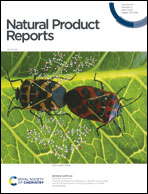Analytical methods for the analysis of volatile natural products
Abstract
Covering: 2000 to 2022
This article reviews the latest developments of analytical methods of volatile natural products. Volatile organic compounds (VOCs) released from biological systems correspond to a series of compounds, originating from primary and secondary metabolites. These compounds are important for intra- and interspecies chemical communication and interaction of living organisms. These valuable natural products can find applications in many fields, including foods, human nutrition, pharmaceuticals, perfumes, cosmetics and so on. Therefore, the deciphering of their structures is of increasing importance in many fields of natural product chemistry. Due to the large diversity of these compounds, there is no “single” analytical instrument or method that can be used to study all of them. Furthermore, most of the volatile compounds can be collected only in low concentrations. Therefore, their detection, identification and structural characterization are challenging tasks. The review briefly describes the extraction and preparation methods of samples, then introduces the tools of instrumental analysis utilized to identify or quantify the VOCs of natural products, including spectroscopic and mass spectrometric methods, such as offline GC-MS, multi-dimensional GC-MS, and online approaches including PTR-MS, SIFT-MS, SEMI-MS, DART-MS etc. The current challenges of analytical techniques and future directions are also briefly discussed.

- This article is part of the themed collection: Volatile Natural Products


 Please wait while we load your content...
Please wait while we load your content...